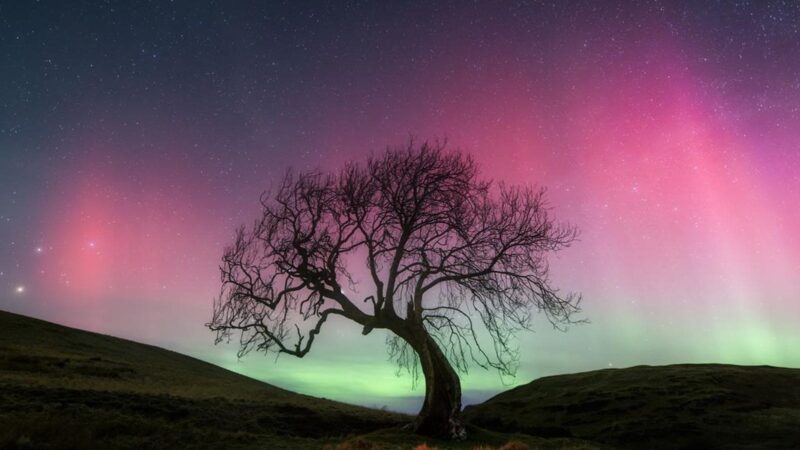Topline
The northern lights could be visible across as many as 16 northern states in the U.S. on Sunday, Nov. 9, into Monday, Nov. 10, with a G2 geomagnetic storm being forecast by space weather experts at the National Oceanic and Atmospheric Administration. It comes in the wake of a trio of X-class solar flares, the latest an X1.7 event on the morning of Sunday, Nov. 9.
Strong Pink – Green aurora over a very unique tree in Perthshire.
getty
Key Facts
The latest NOAA forecast includes an intensity o f around Kp 6 (the Kp index runs from 0 to 9) for Sunday night, indicating the northern lights may be visible from northern U.S. states.
A geomagnetic storm rated G2 is predicted on a scale of G1-G5, with the most likely timings being in the three hours after 10:00 p.m. PST on Sunday, Nov. 9 and after 1:00 a.m. EST on Monday, Nov. 10.
Sunday’s northern lights forecast follows strong G3 geomagnetic storms late Thursday and early Friday in the wake of X1.1 and X1.8 solar flares, which saw aurora borealis visible in 22 states.
NOAA’s aurora viewline forecast for Sunday, Nov. 9, into Monday, Nov. 10, 2025.
NOAA
Where Will The Northern Lights Be Visible?
Northern Canada and Alaska have the highest likelihood of viewing the northern lights. U.S. states that may see aurora include Alaska and (northerly parts of) Washington, Oregon, Idaho, Montana, Wyoming, North Dakota, South Dakota, Minnesota, Iowa, Wisconsin, Michigan, New York, Vermont, New Hampshire and Maine, according to NOAA’s latest aurora viewlines.
According to the Geophysical Institute of the University of Alaska Fairbanks, highly active auroral displays may be visible overhead from Alaska and northern Canada, but also from Helena, Minneapolis, Milwaukee, Bay City, Toronto and Montpelier in the U.S. Aurora could be visible low on the horizon from Salem, Boise, Cheyenne, Lincoln, Indianapolis and Annapolis.








